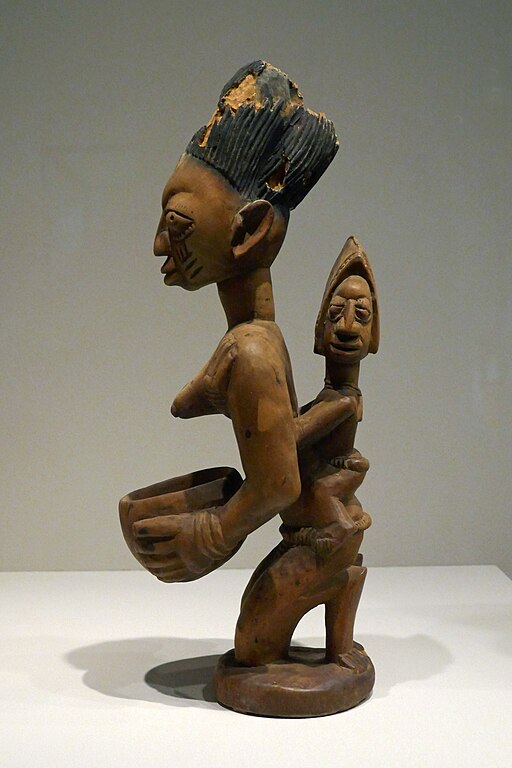
Image by David Guiterrez from Wikimedia
Top 10 Facts about the National Museum of African American History and Culture
The National Museum of African American History & Culture (NMAAHC) is the culmination of a centuries-long struggle to recognize the importance of the black community in the social fabric of American life. The museum houses exhibit galleries, administrative spaces, theatre space and collections storage space for the NMAAHC.
The Museum opened in Washington, D.C. on Sept. 24, 2016 and boasts an extensive collection of civil rights, music, photography, literature, and slavery-related items, as well as pieces in a host of other categories. The national African American museum idea dates back to 1929 when President Herbert Hoover appointed a building commission, which Congress ultimately failed to authorize. However, in 2003, President George W. Bush signed legislation for the museum to be built.
The National Museum of African American History and Culture is the only national museum devoted exclusively to the documentation of African American life, history, and culture. Established following decades of efforts to promote and highlight the contributions of African Americans to date, the museum has collected more than 40,000 artifacts and a membership of 100,000 individuals. The Museum opened its doors to the public as the 19th museum of the Smithsonian Institution. Continue reading this article to learn about the top 10 facts about the National Museum of African American History and Culture.
1. Symbolic African American Elements were Incorporated into the Museum’s Building Design

Image by Ji-Elle from Wikimedia
The design rests on three cornerstones: the “corona” shape and form of the building; the extension of the building out into the landscape – the porch; and the bronze filigree envelope.
Tanzanian-born British architect David Adjaye the lead designer said “This is a museum where the container and the content are one.” The five-story building is inspired by a Yoruban caryatid, which is a column popular in West Africa with a corona at its peak. The building’s patterns also allude to the architecture found in Georgia and South Carolina that was built by enslaved and freed Blacks. This metalwork inspired Mr. Adjaye and the bronze color and shape of the building is an additional aspect similar to that Southern style of architecture.
The whole exterior is wrapped in a metal lattice that resembles the ironwork traditionally forged by enslaved African Americans in cities such as Charleston and New Orleans. According to Architizer, “The architects studied iron railings and façade ornaments from South Carolina and Louisiana before selecting a historic grille as the basis of their design. They then used digital modeling software to abstract the pattern, giving it a contemporary flair.”
According to David Adjaye, he envisioned the museum evoking a sense of “praise.” He told Smithsonian Magazine, “It’s the idea that you come from the ground up, rather than crouching down or leaning. The form of the building suggests very upward mobility . . . This is not a story about past trauma. For me, the story is one that’s extremely uplifting, as a kind of world story. It’s not a story of a people that were taken down, but actually, a people that overcame and transformed an entire superpower into what it is today. The sacrifices of the African-American people have made America better.”
2. The Difficult Push to create this Museum Began in the 1800s

Image by ACE-IT NAB from Wikimedia
The idea to create a museum that honored African-American history started from a desire to create a museum that honored Black Civil War veterans. After different trials of honoring African Americans with a national museum festered, the strongest push came in the 1980s. In 1988, Mickey Leland who was a Representative in the United States House of Representatives from the state of Texas, co-sponsored legislation with fellow Representative and Civil Rights legend John Lewis of Georgia to establish a museum honoring African-American history.
Mr. Leland died in a plane crash the next year, so Mr. Lewis took up the cause, each year for the next fifteen years, Mr. Lewis proposed his legislation but it was defeated. In 1994, it passed the House of Representatives but staunch segregationist Jesse Helms of North Carolina filibustered against the bill and it died in the Senate. It was not until the early 2000s when Republicans like Representative J.C. Watts of Oklahoma and Senator Sam Brownback of Kansas showed their support that the bill was passed. On December 16, 2003, George W. Bush signed H.R. 3491 into law which authorized a Smithsonian Institution museum created to honor the legacy of African Americans in America.
Learn more about African-American history.
3. NMAAHC is the Largest African American Museum

Image by Rhododendrites from Wikimedia
The National Museum of African American History and Culture is the nation’s largest and most comprehensive cultural destination devoted exclusively to exploring, documenting and showcasing the African American story and its impact on American and world history.
It is located on the National Mall, adjacent to the Washington Monument with 10 floors of interactive exhibits (5 above and 5 below ground) devoted exclusively to exploring, documenting, and showcasing the African American experience.
Established by an Act of Congress in 2003, the nearly 400,000 sq ft museum is prominently located next to the Washington Monument. This museum is the culmination of decades of efforts to establish a national museum of African American culture.
It is also interesting to note, the first African American museum was the College Museum in Hampton, Virginia, established in 1868. Prior to 1950, there were about 30 museums devoted to African American culture and history in the United States.
4. It is Most popular amongst the Smithsonian Museums
The National Museum of African American History and Culture (NMAAHC) is a Smithsonian Institution museum located on the National Mall in Washington, D.C., in the United States. It was established in December 2003 and opened its permanent home in September 2016 with a ceremony led by President Barack Obama.
When it opened in September 2016, the museum topped the 1 million mark in visitors in just over four months, breaking all records for any of the museums in the Smithsonian system. The museum’s “dwell time,” the length of time a visitor stays in a museum, is unparalleled—averaging six hours or more on weekends, compared to 75 minutes to two hours for most museums.
5. The Collection of the National Museum of African American History and Culture was sourced from the Public

Image by Gordon Makryllos from Wikimedia
When the museum was authorized by Congress in 2003, it had no collection. Unlike any of the Smithsonian’s eighteen previous museums, this museum’s collection was built from scratch. The National Museum of African-American History and Culture was created without any artifacts at hand. Museum Director Lonnie Bunch and the other organizers of the museum had the monumental task of building the collection from scratch.
After years of work to populate its archives, the museum has collected more than 36,000 artifacts and has nearly 100,000 charter members. To grow a collection, the organizers came up with the unique idea of “Saving African-American Treasures,” which was a 15-city tour launched in 2009. During this effort, they encouraged Americans to donate family heirlooms to the museum. The result was amazing as priceless artifacts were found hidden in the community. Exhibits in the National Museum of African American History and Culture span more than four centuries, from the early slave trade to the present.
Many artifacts are from Louisiana, including a deed of sale for two men auctioned in a New Orleans slave market, a chef’s jacket and cookbook from renowned New Orleans restaurateur Leah Chase, clothing and shoes from R&B legend Fats Domino, an exhibit about the Deacons of Defense self-defense group from 1960s-era Bogalusa, a helicopter rescue basket used in the aftermath of Hurricane Katrina, a painting by Clementine Hunter and a guard tower from Camp H at the Louisiana State Penitentiary at Angola. It is estimated that over half of the Museum’s artifacts came from donations.
6. Over 75% of Financial Donations from Individuals came from the African American Community!

Image by Rhododendrites from Wikimedia
In 2003, Congress passed the legislation establishing the Museum and pledged to fund $270 million or half of the Museum’s expense as the final price tag was $540 million. Interestingly, previous Smithsonian museums had received all or most of their funds from the government. The shortfall was made up by donations from major corporate sponsors and our community. Churches, fraternities, sororities, celebrities and civic organizations were mobilised for the fundraising effort. Over 75% of donations from individuals came from the African American community. Over $4 million in funds came from people donating in amounts less than $1,000. Oprah Winfrey is the largest donor at $21 million. As of this writing, the Museum has raised over $315 million in private funds which far exceeded the congressional requirement.
7. Lonnie G. Bunch III is the Founding Director

Image by Fuzheado from Wikimedia
Lonnie G. Bunch III is an American educator and historian who as the 14th Secretary of the Smithsonian Institution was the first African American and first historian to serve as head of the institution. He has spent most of his career as a history museum curator and administrator. He is the founding director of the Smithsonian’s National Museum of African American History and Culture.
In this position, he was tasked to set the museum’s mission, coordinate its fundraising and membership campaigns, develop its collections, establish cultural partnerships and oversee the design and construction of the museum’s building. While serving as an assistant director for curatorial affairs at NMAH (1992-1994), Bunch developed “Smithsonian’s America,” an exhibition that explored the history, culture, and diversity of the United States. The exhibition was shown in Tokyo, Japan as part of the “American Festival Japan ’94.” He also supervised the planning and implementation of the museum’s research and collection agendas.
Further, Bunch served as the curator of history for the California Afro-American Museum in Los Angeles from 1983 to 1989. There he organized several award-winning exhibitions including “The Black Olympians, 1904-1950” and “Black Angelenos: The Afro-American in Los Angeles, 1850-1950.” Committed to making history accessible, he also produced several historical documentaries for public television. He has traveled internationally and given lectures on education and museum curation to professionals throughout the globe. He was appointed the Founding Director of the National Museum of African-American History and Culture in 2005.
8. The National Museum of African American History and Culture is Divided into 10 Major Galleries

Image by Adams Jones from Wikimedia
Inside the building, visitors are guided on a historical and emotional journey, characterised by vast, column-free spaces, a dramatic infusion of natural light and a diverse material palette comprising pre-cast concrete, timber and a glazed skin that sits within the bronze-coated aluminium lattice. Below ground, the ambiance is contemplative and monumental, achieved by the triple-height history gallery and symbolised by the memorial space – the “oculus” – that brings light diffused by a cascade of water into the contemplative space from the Monument grounds. Moving upwards, the views become pivotal, as one circulates along the corona with unrivalled panoramas of the Mall, Federal Triangle buildings and Monument Grounds. Below is how the galleries are thematically organized into;
History Galleries
- Slavery and Freedom Gallery
- Defending Freedom, Defining Freedom: Era of Segregation (1876–1968)
- A Changing America: 1968 and Beyond
Culture Galleries
- Musical Crossroads
- Cultural Expressions
- Visual Arts Gallery
Community Galleries
- Power of Place
- Making a Way Out of No Way
- Sports Gallery
- Military History Gallery
9. The Museum’s Bronze-Colored Wrapper Is Called the ‘Corona’

Image by Rhododendrites from Wikimedia
During the design phase the most frequently asked question was, would the building look African American? The signature exterior feature—the metal screens enclosing the museum—is called the “Corona.” Each customized, bronze-colored, cast-aluminum panel (3,600 in all) reflects the design of ironwork by enslaved craftsmen in both Charleston and New Orleans.
Remarkably, the facade system weighs 230 tons, since it’s essentially draped from the top of the building—not stacked, as it might physically appear. The panels come on a pre-assembled frame; the frames hang on a series of outriggers, which are the supports that give the exterior its sawtooth shape; and the outriggers are suspended from a belt-truss system joined to the fifth floor.
These panels accomplish several things at once. They prevent glare and heat gain inside the building. The variegated transparency of the panels privileges certain views and obscures others—meaning that the size of the holes or apertures vary from panel to panel. The architects achieved this useful but complicated differential “porosity” using algorithmic design software.
The facade is both modern and narrative. Bunch described the building as a “monument to the work of the people who made this country possible, but whose work is hidden in plain sight.” The density of the latticework can be modulated to regulate the amount of natural light in the galleries. Most important is that the building’s exterior “corona” shape echoes the crowns worn by queens in ancient Yoruban sculpture.
10. The Theater in the Museum Is Named after Oprah Winfrey

Image by Ted Eytan from Wikimedia
The Oprah Winfrey Theater at the National Museum of African American History and Culture (NMAAHC) is located below ground, opening directly into Concourse C of the History Galleries. The main theatre entrance is off the main lobby, down a great circular steel staircase.
The 355-seat theatre was designed to support a broad range of uses including events, symposia, curator talks, conferences, corporate meetings and presentations, awards ceremonies, live theatrical performances, dance, live music (from jazz to string ensembles), feature films, documentaries, archival media in a variety of formats and other special programming.
Conceived as a true multipurpose room, the theatre features motorized rigging, variable acoustics banners, and a complete inventory of LED theatrical lighting fixtures on automated lighting battens. After Oprah gave an extraordinary gift to the NMAAHC’s capital campaign in 2013, the Smithsonian Institution announced that it would name the room the Oprah Winfrey Theatre. Individual donors like Oprah don’t make up the bulk of the museum’s funders, though. Congress paid 50 percent of the costs for the building and staff. Of private money raised, 43 percent came from corporate sources.
For more information on Oprah Winfrey, click here.
The NMAAHC is a public institution open to all, where anyone is welcome to participate, collaborate, and learn more about African American history and culture. In the words of Lonnie G. Bunch III, founding director of the Museum, “there are few things as powerful and as important as a people, as a nation that is steeped in its history.”
Practical Information
Located in: National Mall
Address: 1400 Constitution Ave. NW, Washington, DC 20560, United States
Phone: +1 844-750-3012
Hours: Monday: Noon to 5:30pm Tuesday – Sunday: 10:30am to 5:30pm
Planning a trip to Paris ? Get ready !
These are Amazon’s best-selling travel products that you may need for coming to Paris.
Bookstore
- The best travel book : Rick Steves – Paris 2023 – Learn more here
- Fodor’s Paris 2024 – Learn more here
Travel Gear
- Venture Pal Lightweight Backpack – Learn more here
- Samsonite Winfield 2 28″ Luggage – Learn more here
- Swig Savvy’s Stainless Steel Insulated Water Bottle – Learn more here
Check Amazon’s best-seller list for the most popular travel accessories. We sometimes read this list just to find out what new travel products people are buying.










